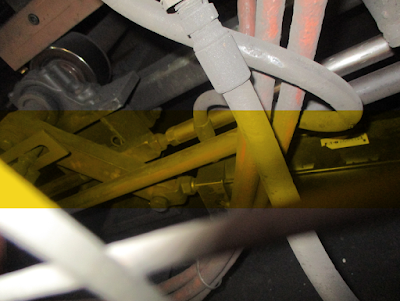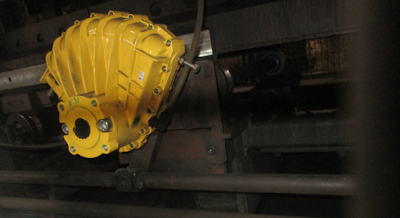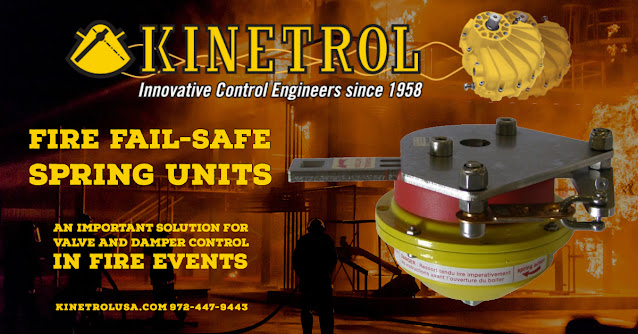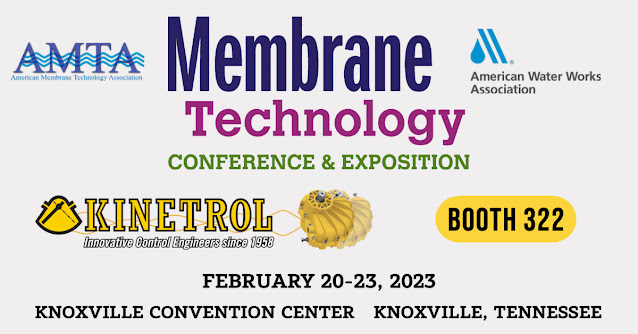The Kinetrol rotary vane design is based upon a single moving part which eliminates additional parts required to convert linear motion to rotary motion. This simple and innovative design provides a highly accurate and extremely reliable actuator for operating valves, drives and dampers, and is perfectly suited for the most demanding process control applications. For more information visit www.kinetrolusa.com or call 972-447-9443.
The Backbone of Excellence: Kinetrol USA's Industrial and Municipal Distributor Network
Kinetrol D-Line Damped Manual Fail-Safe
Kinetrol USA
https://kinetrolusa.com
972-447-9443
New VDI/VDE Actuator Interface for Kinetrol Double-Acting Actuators
Kinetrol is pleased to announce the availability of Double-Acting Actuators with VDI / VDE 3845 (NAMUR) mounting interfaces.
Models 03 and 05 DA Actuators
Models 07 and 08 DA Actuators
Models 09 and 10 DA Actuators
Models 12, 14 and 15 DA Actuators
Order Codes and Prices
Availability
Kinetrol USA
https://kinetrolusa.com
972-447-9443
The Steadyline Series: Kinetrol's Answer to Ultra-Reliable Valve Actuation with Enhanced Valve Damping Features
- Water Hammer: This is one of the most commonly known problems resulting from the rapid closing or opening of valves. Also known as hydraulic shock, water hammer occurs when a fluid's flow rate changes, causing a sudden increase in pressure producing shock waves that travel through the fluid in the pipes. The resulting forces can damage pipes, valves, and other equipment.
- Cavitation: This occurs when the pressure of a liquid drops below its vapor pressure, leading to the formation of vapor bubbles. When these bubbles move to an area of higher pressure, they collapse, causing localized shock waves, eroding the valves and pipes' material, and leading to premature equipment failure.
- Surge Pressures: Similar to water hammer but typically in systems with gases, rapid valve closure or opening can result in a pressure surge, damaging the system.
- Pump Issues: Rapidly closing a valve downstream of a pump can result in a sudden increase in pressure, which might cause the pump to work against a "dead head" condition, leading to overheating and potential damage to the pump.
- Instrumentation Errors: Rapid changes in flow rates can cause instrumentation reading errors, as many flow meters and sensors require steady-state conditions for accurate measurements.
- Process Upsets: Rapid valve actions can lead to unexpected changes in process conditions, potentially affecting product quality or even causing unsafe conditions.
- Noise: Fluids' sudden acceleration or deceleration can create noise due to vibrations. Over time, this can also contribute to material fatigue.
- Seal and Gasket Failure: The sudden change in pressure and flow can exert excessive stress on seals and gaskets, leading to premature failure.
- Mechanical Stress: The physical stress from rapid valve actions can weaken pipe supports, joints, and valve mechanisms.
Kinetrol USA
https://kinetrolusa.com
972-447-9443
Kinetrol Fire Fail-Safe Spring Units: An Important Solution for Valve and Damper Control in Fire Events
Kinetrol Spring Packs: Unleashing the Power of Advanced Torsion Spring Technology for Superior Performance
Torsion and helical compression springs are mechanical springs used for storing and releasing energy in various applications. However, in engineering terms, torsion springs perform better than helical compression springs for rotational motion due to their inherent design and functioning principles.
Torsion springs store and release rotational energy through the action of twisting. When a torsion spring twists, it stores potential energy in mechanical strain, which releases as the spring returns to equilibrium, allowing for a direct and efficient energy transfer in rotational applications.
On the other hand, helical compression springs are designed for linear motion and store energy when subjected to an axial compressive force. The spring compresses under load, storing potential energy as mechanical strain, and releases it as the spring returns to its uncompressed state. Due to their linear nature, helical compression springs are not as well-suited for rotational motion as torsion springs. Their energy transfer is less direct and efficient in these applications. Instead, they must include a rack and pinion mechanism for rotational movement. The use of these extra components introduces several disadvantages:
Disadvantages of helical compression springs for rotational movement:
- Increased complexity: The rack and pinion gear system adds complexity to the design, requiring additional components and maintenance compared to a torsion spring system.
- Lower efficiency: The energy transfer through the rack and pinion system is less direct and efficient, requiring converting linear motion from the helical compression spring into rotational motion.
- Backlash: The rack and pinion system may introduce backlash, which is the unwanted play between the gear teeth, potentially leading to imprecise motion control and increased wear over time.
- Space requirements: The additional components and assembly of the rack and pinion system require more space compared to a torsion spring, making it less suitable for compact applications.
Torsion springs outperform helical compression springs in rotational motion applications because their design and functioning principles allow for a more direct and efficient energy transfer. Torsion springs are better suited to meet the demands of rotational motion applications by storing and releasing energy through twisting rather than axial compression.
Kinetrol, a leader in precision-engineered mechanical components, manufactures highly reliable, low-stress, clock-type spring units for their broad line of pneumatic actuators and as stand-alone spring packs. Their "clock-type" design delivers unmatched reliability and performance, making them the preferred choice of mechanical engineers seeking to enhance efficiency and safety. These robust and resilient spring units can be seamlessly integrated into a wide range of non-Kinetrol applications, offering engineers the flexibility they require to address diverse design challenges. With their superior torsional characteristics, these spring packs are especially well-suited for applications such as spring return mechanisms and fail-safe operations, where consistent and dependable force output is paramount.
Advantage summary for Kinetrol Spring Packs:
- Angular force: Torsion springs exert a rotational or angular force, making them ideal for applications requiring rotational movement, such as quarter-turn actuators. On the other hand, helical compression springs exert a linear force, which is suitable for applications involving compression, but not for rotational motion.
- Space efficiency: Torsion springs can be more space-efficient than helical compression springs in specific applications. Their spiral design allows them to be compact and fit into tight spaces while providing the required force. It is advantageous in applications with limited space or the design demands a smaller footprint.
- Stability: Torsion springs can provide excellent stability in some applications, maintaining their force over a wide range of angular deflection allowing for more precise control and consistent performance in certain situations.
- No need for additional hardware: Torsion springs can apply force directly to the component they are working on without needing other hardware to accommodate rotational movement, simplifying the overall design and reducing the number of parts.
Kinetrol Actuators with Epoxy Stove Enamel Finish: A Winning Combination for Enhanced Durability and Style
Epoxy stove enamel external finish offers several advantages for various applications, primarily when used on high-heat equipment. Some of the key benefits of this type of finish include the following:
- Durability: Epoxy stove enamel finishes are known for their exceptional durability. They form a rugged, long-lasting, and abrasion-resistant surface that can withstand high temperatures and protect the underlying material from wear and tear, ensuring a longer lifespan for the equipment.
- Heat resistance: One of the primary advantages of epoxy stove enamel finishes is their ability to withstand high temperatures. These finishes can resist temperatures up to 500 degrees Fahrenheit (260 degrees Celsius) without degrading, peeling, or blistering, making them suitable for stoves and other high-heat equipment.
- Corrosion resistance: Epoxy stove enamel finishes offer excellent protection against corrosion and rust. The epoxy layer forms a barrier that prevents moisture, chemicals, and other environmental factors from reaching the underlying metal, ensuring the equipment stays in good condition for longer.
- Easy cleaning and maintenance: The smooth and non-porous surface of epoxy stove enamel finishes makes cleaning and maintenance a breeze. It does not easily attract dirt, grime, or grease and is cleanable with a damp cloth or mild cleaning solution, helping maintain a clean and hygienic cooking environment.
- Aesthetic appeal: Epoxy stove enamel finishes are available in various colors and finishes, allowing for customization and providing an attractive appearance to the equipment. The high-gloss and smooth finish enhances the appliance's look and gives it a premium feel.
- Chemical resistance: Epoxy coatings resist various chemicals, making them suitable for multiple environments. They can withstand exposure to household cleaners, food acids, and other substances without degrading or staining.
- UV resistance: The epoxy stove enamel finish offers protection against UV rays, preventing the color from fading or chalking over time. It ensures that the equipment maintains its appearance even when exposed to sunlight for prolonged periods.
- Environmentally friendly: Epoxy coatings are generally considered environmentally friendly. They do not emit harmful volatile organic compounds (VOCs) during curing, contributing to a healthier environment and improved indoor air quality.
In summary, an epoxy stove enamel external finish offers a range of advantages such as durability, heat and corrosion resistance, ease of cleaning and maintenance, aesthetic appeal, chemical and UV resistance, and eco-friendliness.
For more information, contact:
Kinetrol USA
https://kinetrolusa.com
972-447-9443
Come See Kinetrol USA at Valve World Expo Americas!
Kinetrol USA Exhibiting in 2023 AMTA/AWWA Membrane Technology Conference
"Failure Is Not an Option" - Kinetrol Manual and Fire Fail-Safe Spring Units
If you want to operate a valve manually, but maintain the advantage of the fail-safe spring's certainty of position when unattended, check out the Kinetrol's manual and fire fail-safe spring handle. This uniquely designed manual operator offers some compelling benefits in automating valves and provides additional plant safety levels. Spring return (also known as "deadman") handles will help you meet individual plant safety requirements and OSHA requirements for valves that must return to the closed position after an operation. Unlike lever handle or gear operators that will leave the valve in the last state, the spring return deadman device ensures that the valve returns to its original starting position powered by the associated spring handle.
Product Update: Kinetrol VLS Limit Switch Box
With the continued pressure for modularization and commonality a new precision die cast switch box will offer some positive improvements over the current model, including more internal space for future developments. The new design is known as the VLS Limit Switch Box.
Reduction in Weight. The unit will offer a reduction in weight of the standard 07 version from 2.32 lbs (1.05 kg) to 1.50 lbs (0.68 kg).
All New Plastic Coupling. Improved access to mounting screws for all electronic options for easy actuator mounting. Coupling is permanently retained in the box and does not need removing.
New coupling has a lower Oring which makes all shafts discretely sealed when not mounted. Coupling retainer is replaced with an integral shoulder on the coupling.
All new switch strikers. Common standard strikers for both mechanical switches and proximity sensor activation.
New Standard V3 Switch (004). New V3 switches offers a more defined switch point.
New Mounting for Model 03 and 05. The VLS Limit Switch Box will be supplied as a Model 07 Female Square as standard, (only one size box) which can then be converted with the use of two adaptor options to suit Model 03 and Models 05 Actuators reducing the number of switch box variations distributors stock. SP1620 - Model 03 mounting kit (includes removable plate coupling and fixings) SP1621 - Model 05 mounting kit (includes removable plate and coupling and fixings)
New Standard Conduit Entries. The conduit entries will remain M20 for ISO and 1/2” NPS for ANSI however the land profile has been changed. The additional entries on the four-entry version remain unchanged.
Switch Options. All switch options will be available including the pneumatic switch option (002) except for ATEX approved versions. ATEX Approved switch options (001, 002, 003 and 009) are currently undergoing ATEX testing and will be available later. As a result, these will continue to use the older design ULS.
Please refer to the Kinetrol coding on the VLS Tech Bulletin located on this Kinetrol USA web page.
Modular Concept. These changes will affect the modular approach when fitting the VLS box to Model 03 and 05 actuators. On actuator Models 07 to 15 there is no change. The discrete option for Models 16 to 30 will now utilize SP1602 07/05 reducer and SP1601 Discrete 05 Drive Adaptor offering a price saving over the old design.
VLS Coding. The coding has been changed to reflect the new design by adding a “V” after the U for non ATEX standard options. ATEX switch options (switch type 001, 002, 003, 009) will remain as “0” after the U in the code.
Examples of code change:
- 097-104U005004M (DA+ULS) becomes 097-104UV05004M (DA+VLS)
- 077-004U005004M (ULS) becomes 077-004UV05004M (VLS)
- 077-001U001000 (ULS ATEX) is unchanged
Angle Retransmit and Pot Assembly – The new Angle Retransmit and Potentiometer uses a geared coupling which replaces the standard coupling when fitted. This new design will also offer an additional price savings. The old ULS Angle Retransmit assembly is not compatible to retrofit with the new VLS unit. All other options are unchanged including AS-interface, Terminal Blocks, Multi-Terminal PCB.
How To Install and Remove a Kinetrol Actuator Spring Unit
Kinetrol Actuator in 60 Deg. Rotation, Continuous Cycling Application on Permanent Mold Casting Machine
 |
| Hydraulic cylinder (shaded in yellow) and it's associated rods and yokes. Note the difficult access and adjustability. |
- No waste from the mold
- Reusable mold
- Good surface finish
- Good dimensional accuracy
- High production rates
- Higher conductivity levels
 |
| Kinetrol actuator replacement. The actuator mounts directly to equipment, connected directly to the shaft eliminating the need for rods and yokes. |
The local Kinetrol Distributor was called in and immediately saw the opportunity to replace the hydraulic cylinder, rods, and scotch-yokes with a Kinetrol actuator and simple mounting.
The Kinetrol actuators have been working for several years now, moving continuously without problem and eliminating the need for frequent adjustments.
For more information, contact:
Kinetrol USA
https://kinetrolusa.com
972-447-9443
Upgrade in Steam Balancing Valve Actuators at Combined-cycle Power Plant Lead to Kinetrol
 The customer for this application note is an electrical power station with a combined-cycle, natural gas-fired generating unit with two combustion turbines, two heat recovery steam generators and one steam turbine. The output of combustion turbines can vary at different times throughout the year. The nominal output for this facility is 577 megawatts. The station burns natural gas.
The customer for this application note is an electrical power station with a combined-cycle, natural gas-fired generating unit with two combustion turbines, two heat recovery steam generators and one steam turbine. The output of combustion turbines can vary at different times throughout the year. The nominal output for this facility is 577 megawatts. The station burns natural gas.A combined-cycle power plant uses a gas and a steam turbine together to produce up to 50% more generated electricity, using the same fuel, when compared to a traditional simple-cycle plant. The gas turbine waste heat is routed to the nearby steam turbine which, in turn, generates the extra power.
One of the most common components for managing high-pressure steam in a combined-cycle plant is the HRH bypass valve (HRH stands for "hot reheat"). Since the valve actuator controls the valve’s ability to reliably and accurately respond to system demands, it can be argued it is one of the most important elements in the steam bypass system, and therefore the entire combined-cycle plant.
 In this application, the customer had two 18" steam balancing valves using large, high torque, scotch-yoke actuators that had to cycle 20 times a day. These actuators presented significant performance issues (they were failing), plus they were very large which presented maintenance difficulties.
In this application, the customer had two 18" steam balancing valves using large, high torque, scotch-yoke actuators that had to cycle 20 times a day. These actuators presented significant performance issues (they were failing), plus they were very large which presented maintenance difficulties.The customer approached the local Kinetrol USA Distributor and inquired if they could suggest a better alternative. The goal was to provide replacement actuators that provide very high torque, be highly reliable, and save space.
The Distributor recommended Kinetrol Model 30 pneumatic rotary actuators. The Model 30 provides 168000 lbf ins (19140 Nm) at 100 psi (7 bar) of torque and were significantly smaller and lighter than the legacy scotch-yoke actuators. Most importantly, they carried the world-renowned Kinetrol reputation for outstanding reliability, long life, and maintenance-free operation.
Kinetrol USA
https://kinetrolusa.com
972-447-9443
Demonstration of NAMUR Mount Solenoid Valve with Manual Bypass Option on Kinetrol Actuator
Why Do Kinetrol Actuators Last So Long?
Kinetrol actuators are known world-wide for their extremely long service life, even in harsh environments. Here are a few reasons why.
KintrolUSA.com
972-447-9443
Kinetrol Actuator "Insures" Rapid Valve Closing to Protect Equipment, Infrastructure, and Personnel
 |
| 20" high performance butterfly valve with Kinetrol actuator |
 The biggest challenges: stroking the valve in under one second, but without slamming the butterfly disc into the stops which can damage the valve and nearby equipment.
The biggest challenges: stroking the valve in under one second, but without slamming the butterfly disc into the stops which can damage the valve and nearby equipment. Challenging Steam Balancing Valve Application at Southwest Power Plant
 |
| Steam balance valve with Kinetrol model 30. |
Outfitting these valves with pneumatic actuators is also difficult. Because of the valve size and valve design, actuators must have high torque output, without taking up vast amounts of space. The actuators must also act quickly and eliminate hysteresis.
Most pneumatic actuator designs simply cannot meet the operating and size restrictions, and hydraulic actuators, with all of their associated maintenance problems, are used instead.
A Kinetrol Distributor in the Southwest USA was asked to recommend a better alternative to a line where very large scotch-yoke actuators controlling two (2) 18" valves were controlling poorly and were taking up too much space.
The Distributor's challenge was to:
- Deliver very high torque output.
- Provide as small a package as possible.
- Improve the actuators stability and reliability.
 |
| Power plant steam balancing valves in service. |
For more information, contact Kinetrol USA by visiting https://kinetrolusa.com or by calling 972-447-9443.











